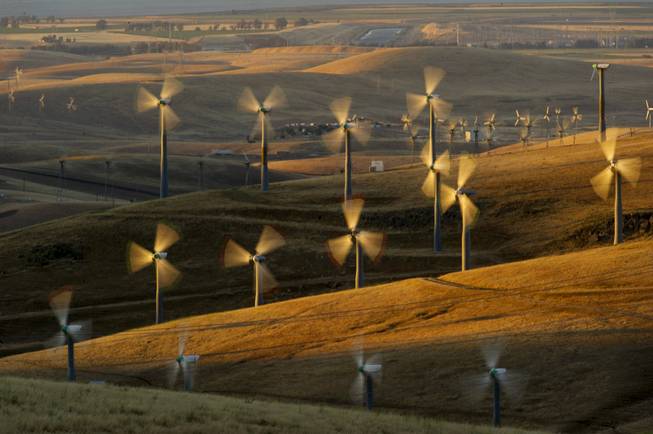
Noah Berger / AP
In this May 12, 2013, photo, wind turbines line the Altamont Pass near Livermore, Calif.
Sunday, Aug. 10, 2014 | 2 a.m.
With all the gusty days that stir up clouds of dust in the Las Vegas Valley, it is easy to assume that Southern Nevada is sitting in a bowl of untapped wind energy.
Positives
Clean fuel source — doesn’t contribute to air pollution.
Renewable power that can’t be used up.
Costs 4 to 6 cents per kilowatt hour, making it one of the lowest-priced renewable energy technologies available.
Negatives
Requires a higher initial investment than fossil-fueled generators.
Good wind sites are often in remote locations, far from cities where the electricity is needed. Transmission lines must be built to bring the electricity from the wind farm to the city.
About the turbine
• Meteorological sensors measure wind direction and speed, and transmit the information to the controller and yaw drive.
• In general, wind turbines are mounted 100 feet or more above ground to take advantage of faster, less turbulent wind.
• Each blade converges at the hub, forming the rotor.
• The blades travel at 6 to 16 revolutions per minute.
• The turbines at Spring Valley Wind Farm are 262 feet tall.
However, there are no new wind energy projects on the horizon in the state, and Nevada has only one wind farm, about 300 miles north of Las Vegas in White Pine County.
Not all winds are created equal. The best winds for generating electricity are consistent and strong, but not too strong. The rugged, mountainous terrain of Nevada does not allow for the consistent winds enjoyed by the country’s greatest wind-power generating states, Iowa and Texas.
“Nevada doesn’t have the big, open expanses that are ideal for wind power,” said Darrell Pepper, an engineering professor at UNLV who has studied the potential for wind energy in the state. “The jagged topography makes winds sporadic. There will be a short section of desert, and then it’s surrounded by mountains.”
And the farther away a wind farm is from a population center, the higher the cost of delivering the electricity. In Nevada, it has been tough to find suitable locations for wind farms that have sufficient winds, enough space for a set of 50 or more turbines and a location not too far from the urban hubs.
HOW A WIND TURBINE CREATES ELECTRICITY
1. As the wind passes, it lifts the blade, spinning the rotor.
2. The rotor turns the low-speed shaft at 30 to 60 revolutions per minute.
3. The gear box connects the low-speed shaft to the high-speed shaft, increasing rotations to 1,000 to 18,000 per minute.
4. The high-speed shaft leads to the generator, which produces 60-cycle AC electricity.
DID YOU KNOW?
• Upwind turbines face into the wind, while downwind turbines face away from the prevailing wind direction.
• A pitch system turns the blades out of or into the wind, controlling rotor speed and preventing the blades from turning in winds that are too slow or fast.
• The controller starts the turbine when winds reach 8-15 mph, and shuts it down when they blow faster than 55 mph, to prevent damage to the turbine.
BY THE NUMBERS
• $225 million: Cost of the Spring Valley project. That’s about $3.4 million per turbine.
• 152: Total megawatts generated by the 66 turbines at the Spring Valley Wind Farm.
• 45,000: Number of average Nevada homes powered by the equivalent of 152MW.
• 905: Number of wind farms in the United States. Texas, California and Iowa lead the nation in wattage generated.

Join the Discussion:
Check this out for a full explanation of our conversion to the LiveFyre commenting system and instructions on how to sign up for an account.
Full comments policy